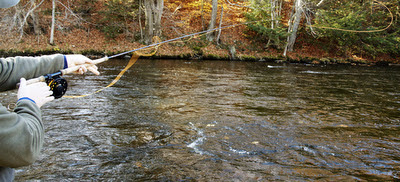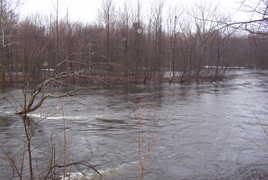

This fly is basically a bugger...with a few extras.
Start by putting the cut shank in the vise, add the mono loop
Next, time to build the tail. I used Arctic fox here but you can also use marabou or rabbit. Add a little flash as well.
Add some sleek brown grizzly hackles to complete the tail. I like thin ones since they really wiggle in the water. Wider hackles are ok too.
Tie in your chenille, wire rib, and hackle that will be wrapped bugger style. Here I am using copper chenille and orange grizzly hackle....
Wrap everything forward to the eye. COUNTER wrap the wire rib, this adds an incredible amount of durability to the fly and allows multiple fish on a fly before the body hackle breaks.
Next take some Black Rhea and either put it in a dubbing loop, or you can do what I did here. Split your thread with a needle, and stuff the trimmed end between the thread fibers. Spread out the Rhea, give your bobbin a good spin to tighten everything, and then wrap the Rhea as a collar. Some of the Rhea will point forward after this step, that's just fine. Pull it back into position over the fly and secure with thread. I like to use flat waxed thread for this trick. I prefer this over a dubbing loop, it's faster and I have more thread control.
Here is what it will look like after all the Rhea has been carefully wrapped into place and secured. Leave it like that and DO NOT fold it down and secure, this will cause the Rhea to lay flat against the fly in the water. We want it to poke out and get washed around by the current, this equals movement!!
Next pick a nice long webby feather from a Pheasant skin. Or any long webby feather of your choice.
Wrap it on as a collar. I don't peel one side of the feather before I wrap it on. This will give a sparse profile to the fly. I like to dress my flies full, and pluck feathers off while on the river if I feel the need for a more sparse profile. Add lead eyes if you wish......
Now time for a wing. Hackle feathers are fine for this as is just about anything you want. Here I am using the burnt orange/brown feather from a Jungle Cock. Pick 2 that are close to matching and tie them in.
This pic shows the JC tied in and I also added a finishing collar of Arctic fox spun the same way I did the Rhea. By splitting the waxed thread with a needle and stuffing the ends between the thread. Again, this can be done using a dubbing loop as well...whip finish and cement.
Top view...
View from the bottom......
Side by side on the Taupo.....
This style of fly can be tied in a ton of various color combos. Some of my favorite are; Brown/copper (the one here), black/purple, Olive, Olive/black, PINK!!!!!!!! hint hint, all Black, and pink purple. Have fun and experiment, just remember to hold on when you fish them!


























































